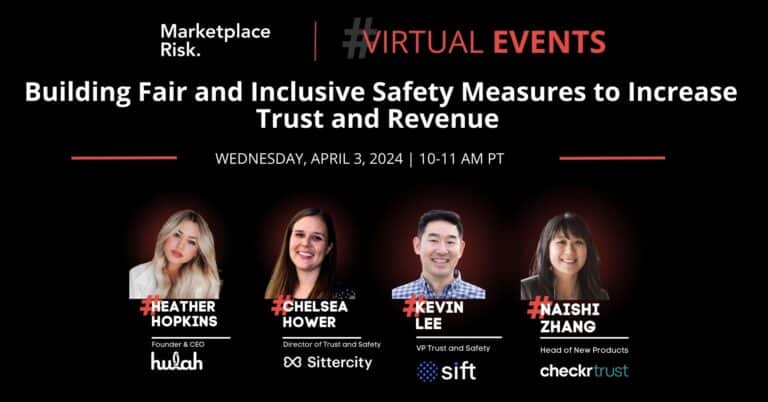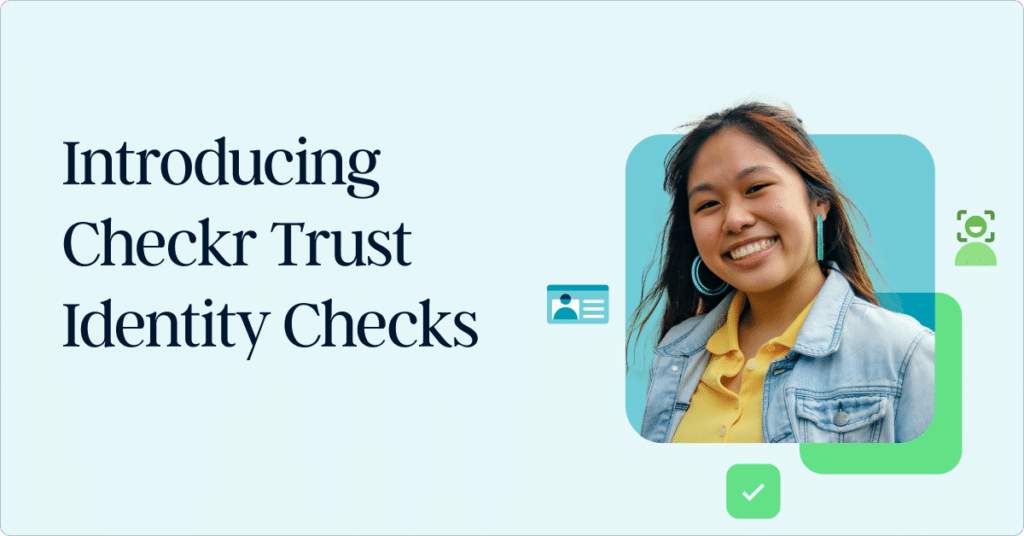Our last webinar tackled Trust & Safety by design, the idea that safety practices and processes can be built into the user journey, and how and why these considerations should be considered as part of the design of the product and customer experiences.
This time, we wanted to think about safety from an angle of fairness and inclusion by asking questions like, What does it mean to build fairness into your platform’s safety measures, and is it possible to prioritize safety and inclusion without sacrificing either? Are safety and inclusion incompatible or are they intertwined?
Read our webinar recap or watch the recording below to see what our panel of Trust & Safety experts had to say.
Meet the speakers:
Heather Hopkins, CEO and Founder at Hulah
Chelsea Hower, Director of Trust and Safety at Sittercity
Kevin Lee, VP of Trust and Safety at Sift
Naishi Zhang, Head of New Products at Checkr Trust
Key Takeaways
- Fair and inclusive safety measures should aim to screen people in rather than out, considering only relevant information.
- Key principles for fair and inclusive safety include being human-centered, prepared, and adaptable.
- It’s important to assess and adapt policies to include new or unanticipated situations.
- Trust and safety measures can be gamified to enhance user experience and promote additional trust on the platform.
Why inclusive safety measures are important
The reality is that 1 in 3 Americans have some sort of record, and it doesn’t make sense to indiscriminately exclude that much of the population. Fair & inclusive safety is the idea that the screening process should aim to screen people in rather than screen people out. There should be nuance, and only relevant information should be considered when deciding whether or not to allow someone to join your platform.
When done right, the result is more participation, more revenue opportunities, and a better user experience.
The panel covered three core tenets in this process:
- Human-centered: There should be nuance when considering screening factors, with consideration for factors like recency and severity.
- Prepared: Thoughtful policy/protocol around fairness and inclusion in safety measures enables premeditated courses of action that are better thought out than knee-jerk reactions.
- Adaptable: Flexibility and a dynamic approach ensures opportunities to incorporate learnings to strengthen fair and inclusive safety measures.
Chelsea Hower noted that these practices require “consistent investment to address changing needs,” while Heather Hopkins asserted that safety measures should be “a core part of the user experience.”
Kevin Lee highlighted the need for systems that can scale and learn, stating that it’s “critical in order to scale and grow an effective community.” He warned that the “speed, scale, and sophistication of fraudsters or bad actors” are increasing, and businesses must be ready to adapt.
Challenges in implementing fair and inclusive safety measures
Panelists noted that implementing fair and inclusive safety measures can present several challenges. These include gaining buy-in, time and resource investment, training, cross-functional alignment, and the impact on user experience. However, these challenges can be addressed with careful planning, constant monitoring, transparency, and preparedness for dynamic situations.
Panelists agreed that while it can be challenging to get buy-in for inclusive safety measures, it’s crucial for keeping platforms safe. Hower weighed in, saying “cross-functional communications are necessary. If you don’t have those cross-functional communications, it just doesn’t work.” When it comes to overcoming the challenge of alignment, she suggested this: “If you’re coming to the table with a problem that is potentially being created, bringing a solution is super important as well.”
However, challenges vary depending on the company. Hopkins explained that because safety is the core of Hulah’s business, “it’s not hard to get us bought in.”
Practical applications and best practices for fair and inclusive safety
The panelists discussed the practical applications and best practices of implementing fair and inclusive safety measures. They emphasized the importance of aligning these measures with their respective company’s mission and values, building relevant policies, and constantly assessing and adapting these measures.
Sittercity
Chelsea Hower shared several areas of where Sittercity, a caregiving platform, is thinking through fair and inclusive safety.
- Photos and names: As photos and names can cause bias, Sittercity is working through how to present these identifiers. However, Hower understands that knowing what someone looks like is a major part of safety when allowing strangers from the internet into a home, and the company needs user information that is legally registered with the government in order to process screenings appropriately.
- Community effort: In addition to internal screening processes, the company created easy ways for users to report offensive or discriminatory content or exchanges. It’s important for the community to know they play a part in this effort as well.
- Parent screenings: Historically, sitters have been screened more extensively, but the company has come to understand that it is important to screen both sides of the marketplace. There are discussions around adding screenings that would protect sitters as well to create greater equity among our users.
Hulah
Part of the appeal of Hulah is the element of exclusivity, where men can only join the online dating platform through a woman’s referral. However, Heather Hopkins said that the company is still invested in inclusion.
Recently, Hulah added another way for men to join the platform — by undergoing a Safety Screening. This allows users to join and be included while the company ensures the men meet their safety standards. Referrals can also opt in to being screened, which gives them a badge on their profiles that might help them stand out.
Sift
Kevin Lee highlighted Sift’s mission to help everyone trust the internet, and he talked about the importance of transparency and accountability in implementing these safety measures. He said, “When it comes to trust and safety and all that encompasses, including fairness and inclusivity, it’s at the core of what we do.”
He offered the idea that “trust is earned in drops and lost in buckets,” and scalability and the ability to learn in real-time are table stakes for those seeking to build safe platforms.
Learn More + Checkr Trust Safety Screenings
If you found this information helpful and want to learn more, or if you’re ready to explore ways that Checkr Trust’s Safety Screening offering can help you build fair and inclusive safety measures, policies, or user experience workflows, we’d love to connect.
Our Safety Screening solution is built for Trust & Safety teams. It’s cost-effective, instantaneous, and highly customizable to ensure we’re screening for the most relevant crimes (keeping your community safe in a fair and relevant manner).
Thanks for tuning in, and we’ll hope to see you online again soon 🙂






